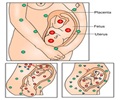Researchers have found sufficient evidence to prove the link between pregnancy, mode of delivery and pelvic floor disorder. It is stated that women who delivered vaginally are the sufferers of pelvic disorders like incontinence or pelvic organ prolapse in contrast to those underwent Cesarean or never gave birth.
Of the women in this study group who gave birth vaginally, 42 percent suffered one or more pelvic floor disorders compared to only 27 percent of the women who delivered only via Cesarean.“Although the study’s outcome showed a statistically higher rate of pelvic floor disorders in the vaginal delivery group, 58 percent of those who delivered vaginally did not suffer a pelvic floor disorder at all,” said Lukacz.
Lukacz says that there has been controversy about whether it is pregnancy, mode of delivery or age alone that causes the pelvic floor disorders.
“Previous studies have argued that there is a link between pregnancy and developing a pelvic floor disorder and others have argued that there is not a link,” Lukacz stated. “The problem has been that previous studies have used different definitions and non-validated instruments. We developed a questionnaire, a validated instrument that addressed all pelvic floor disorders. This is the largest U.S. study using a validated instrument addressing all major pelvic floor disorders.”
The goal of the research was to determine if women who give birth only by Cesarean section have less of a chance of developing a pelvic floor disorder than women who give birth vaginally.
Lukacz stressed that there should not be a widespread effort to steer women toward Cesarean sections because of the associated medical and surgical risks that could be life-threatening.
Advertisement
Lukacz said that pelvic floor disorders are a major problem for women. According to the American Accreditation HealthCare Commission approximately 13 million adults experience incontinence at some point in their lives, with six out of every seven cases occurring in women. And, nearly 11% women will require surgery for a pelvic floor disorder in their lifetime.
Advertisement
Source: Newswise











